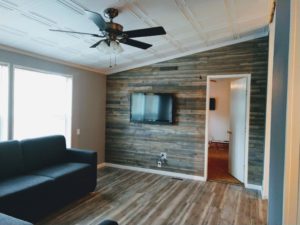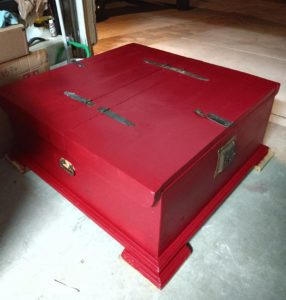 One of the many projects on my list to tackle at the new house in Happy Jack was to remove all the strips in between drywall sheets in the main three open areas. In modular home manufacturing, years ago they would use these strips instead of taping the joints to eliminated cracking and separation when the house was moved. Today’s more modern modular homes don’t do this, and they look more like a traditional built home. We wanted that look in our house, so I had to do some work.
One of the many projects on my list to tackle at the new house in Happy Jack was to remove all the strips in between drywall sheets in the main three open areas. In modular home manufacturing, years ago they would use these strips instead of taping the joints to eliminated cracking and separation when the house was moved. Today’s more modern modular homes don’t do this, and they look more like a traditional built home. We wanted that look in our house, so I had to do some work.
It was fairly easy to remove all the strips. I had to use an x-acto knife to cut the paint around the edges, and then I just pried the hammer claw into the crack and pulled it off. It leaves a fairly good gap in between with lots of nails sticking up. I just hammered the nails back into the wall to make it all smooth.
 The next step was to tape the joints using drywall joint tape. Fancy name, eh? I used the self sticking mesh kind so I could skip the step of mudding the joint first. I have no idea if this was a smart move or not. We’ll see later I’m sure. The video below shows the before and after my tape & float job.
The next step was to tape the joints using drywall joint tape. Fancy name, eh? I used the self sticking mesh kind so I could skip the step of mudding the joint first. I have no idea if this was a smart move or not. We’ll see later I’m sure. The video below shows the before and after my tape & float job.
I watched a few YouTube videos to get an idea of what I was supposed to be doing. What in the world did we do before YouTube? Hire professional?
I bought some joint compound at HomeDepot. Another “I’m not sure which of the 10 varieties I should buy” purchase. It seemed to work out okay. I layered that stuff over the tape and crack and spread it out wide. They refer to this as floating. Drywall is slightly thinner along its outer edges so you can apply a thin layer of drywall mud to even outward seams without building them up. This process of covering a seam with tape and then covering the tape with a thin layer of mud is often referred to as floating drywall. You learn something new everyday.
The next morning I sanded it smooth and patched up a few spots. I still need to sand some more when I get back up there, but it’s good as done. Here’s a preview of the before and after.



